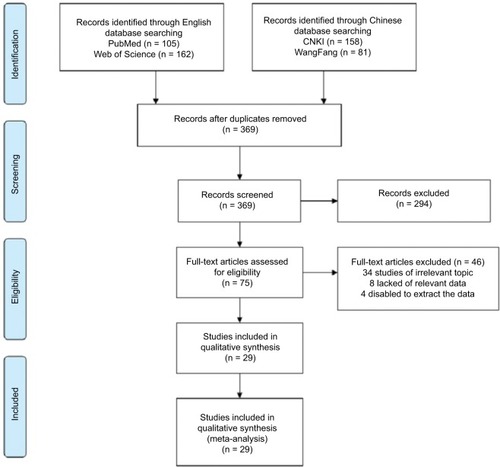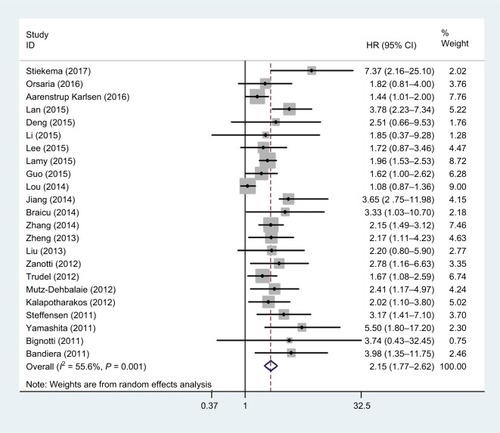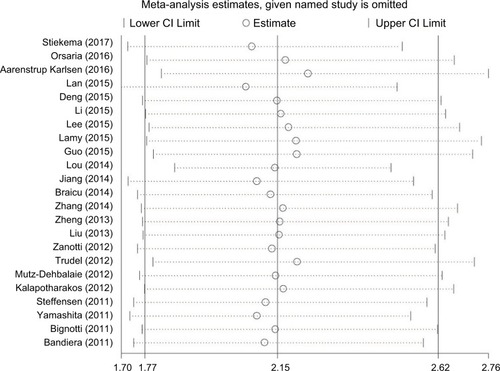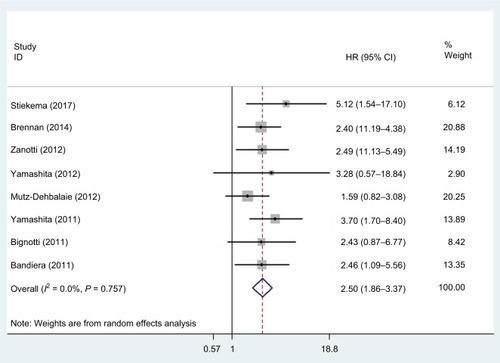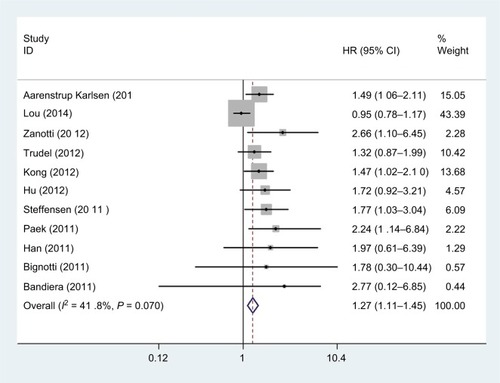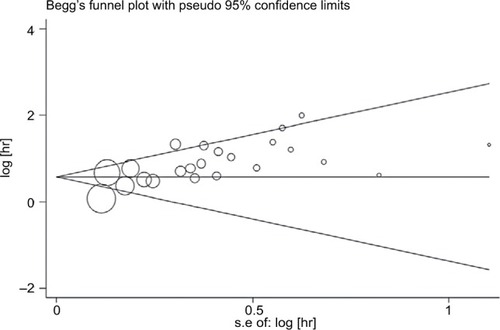Abstract
Background
To evaluate the prognostic impact of HE4 expression in patients with cancer.
Materials and methods
We searched the PubMed, Web of Science, Chinese National Knowledge Infrastructure and WangFang databases for publications concerning HE4 expression in patients with cancer. The correlation of HE4 expression level with overall survival (OS), disease-free survival (DFS), and progression-free survival (PFS) was analyzed.
Results
In this meta-analysis, 29 studies, with a total of 4,235 patients, were included. Our results showed that HE4 expression was significantly associated with poorer OS (hazard ratio [HR] =2.15, 95% confidence interval [CI] =1.77–2.62, P<0.001). Further subgroup analysis found that this correlation was not affected by race (White: HR =1.92, 95% CI =1.53–2.39, P<0.001; Asian: HR =2.62, 95% CI =2.06–3.35, P<0.001) or tumor types (endometrial cancer: HR =2.91, 95% CI =1.86–4.53, P<0.001; ovarian cancer: HR =1.82, 95% CI =1.50–2.22, P<0.001; lung cancer: HR =2.31, 95% CI =1.54–3.47, P<0.001). Our meta-analysis showed that HE4 overexpression was significantly associated with DFS (HR =2.50, 95% CI =1.86–3.37, P<0.001) and PFS (HR =1.27, 95% CI =1.11–1.45, P=0.001).
Conclusion
These results suggest that expression of HE4 was associated with a worse prognosis in patients with cancer. HE4 is a potential novel prognostic factor in patients with cancer.
Keywords:
Introduction
Cancer is a global health problem associated with increasing mortality rates, in spite of advances in diagnostic and therapeutic approaches.Citation1 Several pathological parameters and specific blood tumor markers have been proposed as predictive prognostic factors in cancer.Citation2,Citation3 However, the high incidence of cancer-related deaths indicates a need for reliable and efficient biomarkers for patient stratification and treatment selection.
Human epididymis protein 4 (HE4), also known as whey-acidic-protein four-disulfide core protein-2 (WFDC2), is a member of the protease inhibitor family with immune protective effects and is a promising novel cancer biomarker.Citation4,Citation5 HE4 has been approved by the US Food and Drug Administration as a new tumor marker for the diagnosis of early stage ovarian cancer.Citation6 Several cancer typesCitation7–Citation9 are associated with HE4 overexpression in the serum and tissues. HE4 overexpression is also associated with cancer progression, and its prognostic value has been investigated in several published studies. However, the results remain controversial, and therefore this meta-analysis was performed to accurately assess the prognostic value of HE4 expression in cancer patients.
Materials and methods
Search strategy
The research databases PubMed, Web of Science, Chinese National Knowledge Infrastructure and WangFang databases were searched independently by two authors (Cong Dai and Yi Zheng) to obtain all relevant papers published as of August 2017. The following search terms were used: “Human Epididymis Protein 4 or HE4” and “neoplasms or cancer or tumor” and “prognosis.” No language restrictions were applied. Furthermore, references within the retrieved relevant articles were screened to identify potentially eligible studies. Disagreements were resolved by iteration, discussion, and consensus between the two authors.
Inclusion and exclusion criteria
Studies were considered eligible for inclusion if they met the following criteria: 1) studies evaluated the relationship of HE4 expression in patients with cancer with detailed information about overall survival (OS), disease-free survival (DFS), or progression-free survival (PFS); 2) selected cancer cases were pathologically confirmed, and 3) the study provided a hazard ratio (HR) with the corresponding confidence interval (CI), or sufficient data to calculate it. The exclusion criteria were as follows: 1) duplicate publications; 2) animal studies; 3) articles without usable data; 4) reviews, case reports, letters, and conference abstracts without original data.
Data extraction
Two independent reviewers (Cong Dai and Yi Zheng) extracted the details of included studies using a standardized form, and any disagreements were resolved through discussion with a third reviewer (Zhijun Dai). The following information was recorded: first author’s surname, year of publication, number of patients, patient source, tumor types, HE4 assessment method, sample, prognostic outcomes, analytical method, and HR with the corresponding 95% CI.
Methodological quality of the studies
Quality assessment of included studies was conducted independently by two authors (Cong Dai and Tian Tian) following the Newcastle–Ottawa Scale (NOS) criteria,Citation10 and any disagreements were resolved by discussion with a third reviewer (Zhijun Dai). The NOS criteria were scored on the basis of three aspects: 1) subject selection, 2) comparability of subject, and 3) clinical outcome. NOS scores may range from 0 to 9, and a score ≥6 indicates high quality.
Statistical methods
Included studies were divided into three groups on the basis of the parameter that was reported: OS, DFS, and PFS. According to the cutoff values provided by the authors of each study, HE4 expression was designated as “high” or “low.” HR and 95% CI were used to assess the association between HE4 expression and OS, DFS, and PFS. HRs obtained from studies were used directly in further analyses. For studies where HR values were not included explicitly, Kaplan–Meier survival curves or other methods were used to derive HRs from available data.Citation11 Data from the Kaplan–Meier survival curves were read using the Engauge Digitizer version 4.1 software. Heterogeneity among studies was determined by the χ2 test and Q test. If there was no significant heterogeneity (I2≤50% or P≥0.05), a fixed-effect model was used; if significant heterogeneity was found to exist (I2>50% or P<0.05), a random-effects model was used. We further conducted subgroup analyses by race, tumor type, sample, method, and HR estimate. Sensitivity analysis was performed by omitting individual studies to examine the reliability of the results. Probable publication bias was assessed by Egger’s and Begg’s test.Citation12,Citation13 All P-values were two-sided, and P<0.05 was considered statistically significant. Statistical calculations were performed using STATA 14.0 (StataCorp LLC, College Station, TX, USA).
Results
Search results and study characteristics
A total of 369 articles from the primary literature were searched in PubMed, Web of Science, CNKI, and WangFang databases. References within the retrieved relevant articles had been screened, but there were no more potentially eligible studies. As shown in , 340 studies were excluded because they were irrelevant to the analysis or because the primary outcome was insufficient. Finally, 29 available studies were included in this meta-analysis.Citation7–Citation9,Citation14–Citation39
The characteristics of the 29 studies are summarized in . Of the 29 publications, 23 assessed the relationship between HE4 expression and OS, eight studies evaluated the association between HE4 expression and DFS, and eleven evaluated PFS. A total of 4,235 patients from People’s Republic of China, the Netherlands, Italy, Denmark, United States of America, France, Australia, Germany, Japan, Canada, Korea, and Sweden were enrolled with sample numbers ranging from 23 to 373. HE4 status in tumors was assessed by various methods: immunohistochemistry (IHC) (6 studies), electrochemiluminescence immunoassay assay (ECLIA) (2 studies), enzyme immu noassay assay (EIA) (15 studies), and Chemiluminesent Microparticle Immunoassay (CMIA) (5 studies). Study quality assessment, as per the Newcastle–Ottawa quality assessment scale, yielded scores ranging from 6 to 9, with a mean score of 7.6.
Table 1 Main characteristics of all studies included in the meta-analysis
Quantitative synthesis
HE4 expression and OS in cancers
Overall, 23 studies, including 3,564 patients, reported a relationship between OS and HE4 expression level. As heterogeneity among the studies was statistically significant (P=0.001, I2=55.6%), a random-effects model was used. The pooled HR for OS showed that the overexpression of HE4 was significantly associated with reduced OS in cancers (HR =2.15, 95% CI =1.77–2.62, P<0.001, and ).
Table 2 Main meta-analysis results for OS
We also performed subgroup analysis as per race, tumor type, sample, analysis method, and HR estimate (). Subgroup analysis showed that the correlation between OS and HE4 expression did not differ by race (White: HR =1.92, 95% CI =1.53–2.39, P<0.001; Asian: HR =2.62, 95% CI =2.06–3.35, P<0.001) and tumor type (endometrial cancer: HR =2.91, 95% CI =1.86–4.53, P<0.001; ovarian cancer: HR =1.82, 95% CI =1.50–2.22, P<0.001; lung cancer: HR =2.31, 95% CI =1.54–3.47, P<0.001). Subgroup analysis, based on pooled data pertaining to sample, method, and HR estimate, also demonstrated that there was a significant association between OS and HE4 expression. Subgroup analysis of HR estimates found no significant heterogeneity (multivariate analysis: I2=13.4, univariate analysis: I2=47.8).
Included studies were sequentially removed to investigate whether any single study could have an influence on the pooled results. The results of the sensitivity analyses showed () that there was no influence of any single study on stable pooled HR.
HE4 expression and DFS in cancers
Eight studies, with a total of 1,296 patients, provided results pertaining to DFS. There was no significant heterogeneity (P=0.757, I2=0.0%) among the studies, so a fixed-effect model was used to calculate the pooled HR and 95% CI. Our results showed that increased HE4 expression was significantly associated with poorer DFS (HR =2.50, 95% CI =1.86–3.37, P<0.001) ().
HE4 expression and PFS in cancers
As shown in , there were eleven studies, comprising a total of 1,291 patients, that provided results regarding PFS. The pooled data demonstrated that there was a significant association between HE4 expression and PFS (HR =1.27, 95% CI =1.11–1.45, P=0.001). There was no significant heterogeneity (P=0.070, I2=41.8%) among the studies, so a fixed-effect model was used.
Publication bias
In this meta-analysis, both the Begg’s and the Egger’s tests were performed to assess if any publication bias existed in the included studies. Publication bias was observed in studies reporting OS (P=0.051, 0.000) and PFS (P=0.755, 0.003) but not in those reporting DFS (P=0.174, 0.149). The Begg’s plots for the effect of HE4 expression level on OS are shown in .
Discussion
HE4 is a new tumor biomarker, which has been a subject of intense research in recent years. HE4, originally discovered by Kirchhoff in the human distal epididymal epithelial cells,Citation40 is located on chromosome 20 at 20q12-13 and contains five exons and four introns.Citation41 It contains a gene encoding protein domains that have homology with whey acidic protein, by which the product encoded is mainly protease inhibitor.Citation42 As a member of the protease inhibitor family, it has an inhibitory effect on cell proliferation. Previous studies have reported that HE4 overexpression significantly promotes tumor cell apoptosis and adhesion and inhibits cell proliferation, migration, and invasiveness.Citation43 Further, Kong et alCitation44 found in vitro that this antitumor effect may be achieved by regulating the mitogen-activated protein kinase and phosphoinositide 3-kinase/AKT signal transduction pathways. Recently, further studies have been carried out to investigate the association between HE4 overexpression and prognosis in several tumors.Citation45,Citation46 However, the studies were inconclusive because of small sample sizes and inconsistencies in results. Therefore, to evaluate the relationship between HE4 expression and prognosis of cancer patients, we conducted this meta-analysis to mitigate sample size problems of individual studies and enhance the statistical power.
In the present meta-analysis, we analyzed 29 studies, including 3,564 patients, with OS data from 23 studies, DFS data from eight studies, and PFS data from eleven studies. The results indicated that there was no significant difference in the OS, DFS, and PFS outcomes based on HE4 expression status. There was significant heterogeneity in OS across the included studies. In order to ascertain the reason for the heterogeneity, we performed sensitivity analyses, and the results showed that the stable pooled HR was not significantly affected by any individual study. However, subgroup analyses revealed that the heterogeneity may have been due to the HR estimate methods used. Differences in the baseline characteristics of patients and in the HE4 expression cutoff values may have also contributed to the observed heterogeneity. However, for want of relevant data, it was not possible to determine the contribution of each of the above factors to the heterogeneity. In addition, we also found that the correlation between HE4 expression and OS of cancer patients was not affected by race, tumor type, sample source, detection method, or HR estimation method, and we therefore believe that HE4 may serve as a reliable and novel parameter for prognostication and a promising target for anticancer therapy in cancers.
Several previous meta-analyses have been conducted to research the association between HE4 expression and diagnosis and prognosis of cancer patients. For example, Zhong et alCitation47 identified eight studies that involved 1,412 lung cancer patients and showed that high serum HE4 level was a marker of poor prognosis in lung cancer patients, particularly in patients of Asian origin. Compared with previous studies, our meta-analysis has several limitations as well as advantages. Our study is the first meta-analysis to review the role of HE4 in the OS, DFS, and PFS in several cancer types. In addition, to ensure the reliability of results, we have increased the number of studies included in the analysis.
Although we made every effort to conduct a comprehensive analysis, our study has several limitations. First, we tried to analyze the association between HE4 expression and prognosis in all cancer types, but the majority of included studies focused on endometrial cancer, ovarian cancer, or lung cancer. Hence, suitably designed larger future studies are needed to confirm our results. Second, when we evaluated the relationship between OS and HE4 expression, there was obvious publication bias, possibly because positive results are more likely to be published than are negative results. Last, the cutoff value for HE4 expression differed between studies, which may have led to heterogeneity. A standardized baseline value to designate positive/high HE4 expression status is thus needed. Meanwhile, the collection time and survival times were not standard, and this may be one of the sources of heterogeneity.
Conclusion
We found that increased expression of HE4 indicated poor survival outcomes in patients with cancer. Therefore, HE4 is a potential novel prognostic factor in cancer patients.
Acknowledgments
This work was supported by the National Social Science Foundation of China (16BGL183), the Natural Science Foundation of Shaanxi Province (2015JM8415), and the Fundamental Research Funds for the Central Universities of China (2011jdhz55).
Author contributions
ZD, CD, and JL designed the research. CD, YL, and TT contributed to the literature search. PX, MW, and YD carried out the data extraction. YW, ZZ, and QH contributed to statistical analysis. CD and YZ wrote the manuscript. ZD and CD contributed to revision of the manuscript. All authors contributed toward data analysis, drafting and critically revising the paper and agree to be accountable for all aspects of the work.
Disclosure
The authors report no conflicts of interest in this work.
References
- FerlayJSoerjomataramIDikshitRCancer incidence and mortality worldwide: sources, methods and major patterns in GLOBOCAN 2012Int J Cancer20151365E359E38625220842
- AbeSKawaiKIshiharaSPrognostic impact of carcinoembryonic antigen and carbohydrate antigen 19-9 in stage IV colorectal cancer patients after R0 resectionJ Surg Res2016205238439227664887
- JiangHTangEXuDDevelopment and validation of nomograms for predicting survival in patients with non-metastatic colorectal cancerOncotarget2017818298572986428415740
- SpeeckaertMMSpeeckaertRDelangheJRHuman epididymis protein 4 in cancer diagnostics: a promising and reliable tumor markerAdv Clin Chem20135912123461131
- KarlsenNSKarlsenMAHøgdallCKHøgdallEVHE4 tissue expression and serum HE4 levels in healthy individuals and patients with benign or malignant tumors: a systematic reviewCancer Epidemiol Biomarkers Prev201423112285229525169975
- ChangXYeXDongLHuman epididymis protein 4 (HE4) as a serum tumor biomarker in patients with ovarian carcinomaInt J Gynecol Cancer201121585285821633297
- StiekemaALokCKorseCMSerum HE4 is correlated to prognostic factors and survival in patients with endometrial cancerVirchows Arch2017470665566428401338
- Aarenstrup KarlsenMHøgdallCNedergaardLHE4 as a predictor of adjuvant chemotherapy resistance and survival in patients with epithelial ovarian cancerAPMIS2016124121038104527859687
- LamyPJPlassotCPujolJLSerum HE4: An independent prognostic factor in non-small cell lung cancerPLoS One2015106e012883626030627
- StangACritical evaluation of the Newcastle-Ottawa scale for the assessment of the quality of nonrandomized studies in meta-analysesEur J Epidemiol201025960360520652370
- ParmarMKTorriVStewartLExtracting summary statistics to perform meta-analyses of the published literature for survival endpointsStat Med19981724281528349921604
- EggerMDavey SmithGSchneiderMMinderCBias in meta-analysis detected by a simple, graphical testBMJ199731571096296349310563
- BeggCBMazumdarMOperating characteristics of a rank correlation test for publication biasBiometrics1994504108811017786990
- OrsariaMLonderoAPMarzinottoSdi LoretoCMarchesoniDMariuzziLPlacental type alkaline phosphatase tissue expression in ovarian serous carcinomaCancer Biomark201617447948627802199
- LanWGHaoYZXuDHWangPZhouYLMaLBSerum human epididymis protein 4 is associated with the treatment response of concurrent chemoradiotherapy and prognosis in patients with locally advanced non-small cell lung cancerClin Transl Oncol201618437538026329292
- DengLGaoYLiXExpression and clinical significance of annexin A2 and human epididymis protein 4 in endometrial carcinomaJ Exp Clin Cancer Res2015349626362938
- LiXGaoYTanMExpression of HE4 in Endometrial cancer and its clinical significanceBiomed Res Int20152015437468826539494
- LeeYCHuangCCLinDYChangWCLeeKHOverexpression of centromere protein K (CENPK) in ovarian cancer is correlated with poor patient survival and associated with predictive and prognostic relevancePeerJ20153e138626587348
- GuoYDWangJHLuHThe human epididymis protein 4 acts as a prognostic factor and promotes progression of gastric cancerTumour Biol20153642457246425432133
- LouEJohnsonMSimaCSerum biomarkers for assessing histology and outcomes in patients with metastatic lung cancerCancer Biomark201414420721424934363
- JiangYWangCLvBMaGWangLExpression level of serum human epididymis 4 and its prognostic significance in human non-small cell lung cancerInt J Clin Exp Med20147125568557225664073
- BrennanDJHackethalAMetcalfAMANECS GroupSerum HE4 as a prognostic marker in endometrial cancer--a population based studyGynecol Oncol2014132115916524211402
- ZhangYZhengYJiangLZhaoZLiuWThe prognostic value of serum HE4 in lung cancerChin J Radiol Med Prot2014346423426
- BraicuEIChekerovRRichterRHE4 expression in plasma correlates with surgical outcome and overall survival in patients with first ovarian cancer relapseAnn Surg Oncol201421395596224217786
- ZhengHGaoYNGaoWJGaoMYanXExpression of serum human epididymis protein 4 in epithelial ovarian cancer and its correlation with prognosisZhonghua Zhong Liu Za Zhi201335644544924119905
- LiuWYangJChiPDEvaluating the clinical significance of serum HE4 levels in lung cancer and pulmonary tuberculosisInt J Tuberc Lung Dis201317101346135324025389
- ZanottiLBignottiECalzaSHuman epididymis protein 4 as a serum marker for diagnosis of endometrial carcinoma and prediction of clinical outcomeClin Chem Lab Med201250122189219823096757
- YamashitaSTokuishiKMorogaTSerum level of HE4 is closely associated with pulmonary adenocarcinoma progressionTumour Biol20123362365237023001907
- TrudelDTêtuBGrégoireJHuman epididymis protein 4 (HE4) and ovarian cancer prognosisGynecol Oncol2012127351151522967799
- Mutz-DehbalaieIEgleDFesslerSHE4 is an independent prognostic marker in endometrial cancer patientsGynecol Oncol2012126218619122525819
- KongSYHanMHYooHJSerum HE4 level is an independent prognostic factor in epithelial ovarian cancerAnn Surg Oncol20121951707171221833668
- KalapotharakosGAsciuttoCHenicECasslénBBorgfeldtCHigh preoperative blood levels of HE4 predicts poor prognosis in patients with ovarian cancerJ Ovarian Res2012512022909379
- HuSWangMGaoJQiJThe clinical value of serum HE4 for prognosis evaluation in patients with ovarian cancerChina Cancer2012218638640
- SteffensenKDWaldstrømMBrandslundIJakobsenAPrognostic impact of prechemotherapy serum levels of HER2, CA125, and HE4 in ovarian cancer patientsInt J Gynecol Cancer20112161040104721738039
- YamashitaSTokuishiKHashimotoTPrognostic significance of HE4 expression in pulmonary adenocarcinomaTumour Biol201132226527120953751
- PaekJLeeSHYimGWPrognostic significance of human epididymis protein 4 in epithelial ovarian cancerEur J Obstet Gynecol Reprod Biol2011158233834221683503
- HanJJYuMHoustonNSteinbergSMKohnECProgranulin is a potential prognostic biomarker in advanced epithelial ovarian cancersGynecol Oncol2011120151020950846
- BignottiERagnoliMZanottiLDiagnostic and prognostic impact of serum HE4 detection in endometrial carcinoma patientsBr J Cancer201110491418142521468050
- BandieraERomaniCSpecchiaCSerum human epididymis protein 4 and risk for ovarian malignancy algorithm as new diagnostic and prognostic tools for epithelial ovarian cancer managementCancer Epidemiol Biomarkers Prev201120122496250622028406
- KirchhoffCHabbenIIvellRKrullNA major human epididymis-specific cDNA encodes a protein with sequence homology to extracellular proteinase inhibitorsBiol Reprod19914523503571686187
- BingleLSingletonVBingleCDThe putative ovarian tumour marker gene HE4 (WFDC2), is expressed in normal tissues and undergoes complex alternative splicing to yield multiple protein isoformsOncogene200221172768277311965550
- ClaussALiljaHLundwallAA locus on human chromosome 20 contains several genes expressing protease inhibitor domains with homology to whey acidic proteinBiochem J2002368Pt 123324212206714
- GaoLChengHYDongLThe role of HE4 in ovarian cancer: inhibiting tumour cell proliferation and metastasisJ Int Med Res20113951645166022117965
- KongXChangXChengHMaRYeXCuiHHuman epididymis protein 4 inhibits proliferation of human ovarian cancer cells via the mitogen-activated protein kinase and phosphoinositide 3-kinase/AKT pathwaysInt J Gynecol Cancer201424342743624557433
- Chudecka-GłazARzepka-GórskaIWojciechowskaIHuman epididymal protein 4 (HE4) is a novel biomarker and a promising prognostic factor in ovarian cancer patientsEur J Gynaecol Oncol201233438239023091895
- LeeSChoiSLeeYChungDHongSParkNRole of human epididymis protein 4 in chemoresistance and prognosis of epithelial ovarian cancerJ Obstet Gynaecol Res201743122022727862665
- ZhongHQianYFangSYangLLiLGuWHE4 expression in lung cancer, a meta-analysisClinica Chimica Acta2017470109114

